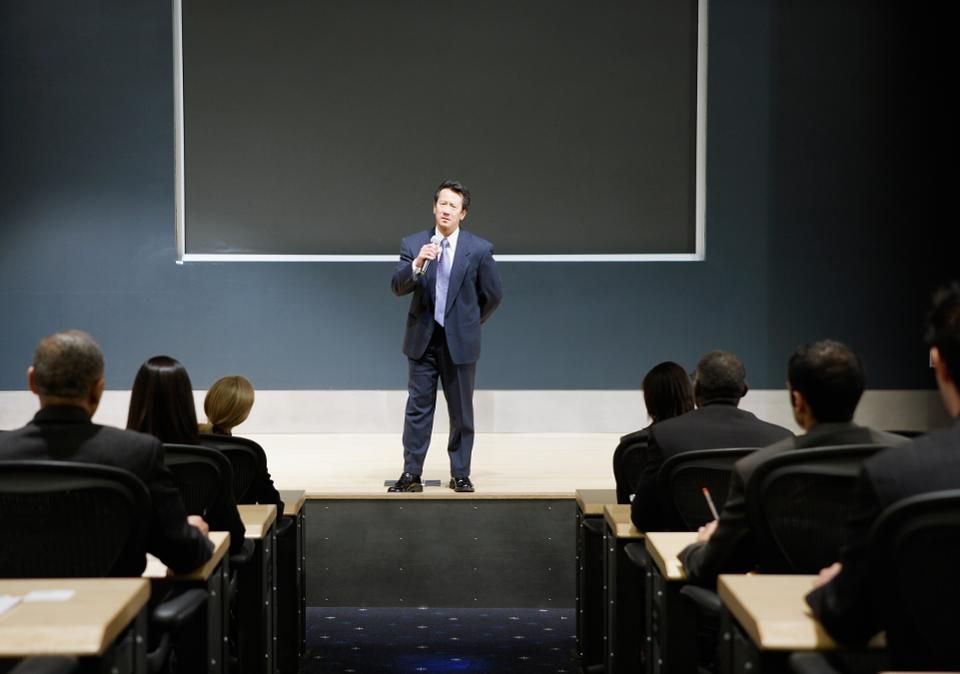For many people, these are the two most terrifying words in the English language: public speaking. But hold on. Before you recoil in fear, here’s something to consider: In today’s world, everyone is bombarded from all sides, at all hours, with social media, salespeople, pundits and politicians trying to tell us what to think and believe and how we should feel.
That’s brought me to an epiphany: I realized that I’m so frequently the target of people speaking at me that I truly appreciate those who want to speak with me.
And therein lies the key to making public speaking successful, enjoyable and worthwhile for your audience and for yourself: Prepare for a conversation with your audience, not a monologue.
The Audience-Centered Approach
There’s nothing mysterious about considering your audience when public speaking, as long as you spend some time truly considering to whom you’re speaking. The communication department at the University of Pittsburgh wrote that “identifying the audience through extensive research is often difficult, so audience adaptation often relies on the healthy use of imagination.”
So, what does that mean? Analyzing your audience is simply the act of making a few reasonable suppositions. Consider the audience’s knowledge of the topic and their demographics. Are they attorneys? Entrepreneurs? Human resources professionals? Is it a local event, or are they traveling from throughout the state or country?
Once you identify who you’re speaking with and what they are looking to learn from you, prepare yourself as if you were going to meet some new, like-minded people at a social event. You’ve done your research, so now think about structure: beginning, middle and end. What is your central idea? What are your main points? What’s your concluding statement, and how will the audience remember it?
Think about your word choice. Keep it conversational, just as if you were at an informal social event. Let your personality come through. Just like swapping stories at a party, you’re certain to have “teachable” moments to share from your own experience, which make your point through humor, success or an unexpected twist.
Once you know who your audience is, you can work on your speech. Below are my tips for getting started:
1. Keep it short and simple.
Build your speech on clarity, not complexity. When Neal Armstrong said, “The Eagle has landed,” that said it all in four simple words.
Stick to a few simple points. I always shoot for five to seven strong points to keep my presentations short. For instance, if I’m given an hour to speak to a group about some aspect of legal investigation, I’ll aim for about 20 minutes for my whole presentation. That leaves plenty of time for questions, which, for me, is the real payoff because this is where I can engage with people as individuals. This transforms listening, a passive activity, into effective action — when a speech becomes a conversation.
2. Know your material, and practice.
This might sound obvious, but you’d be surprised at how many people don’t leave the impression that they understand their topic. Why? They rely on reading from their computer or tablet, or — heaven forbid — recite the words on the projection screen from their PowerPoint presentation.
This might signal to the audience that their time wasn’t worth preparing for. Of course, that’s not what you were intending.
The solution is simple: Load your computer memory with examples, stats and supporting information that you can use in the question-and-answer session. This way, you can focus on memorizing the bigger points and examples that make your points.
This is also where practice helps. Take a cellphone video of yourself, and review it. Where are you stumbling? What makes you most nervous? Do you look relaxed, comfortable and in control? How’s your posture? Identify problem areas, and adjust.
3. Prepare yourself for technical difficulties.
This is where you should consider the advice of Julia Child: “No matter what happens in the kitchen, never apologize.” Most times, that’s the best approach. No matter what goes technically awry in your presentation, it’s not the technology that holds the audience’s attention; it’s you. Don’t call your audience’s attention to the usual technical difficulties.
Used judiciously, slides or video clips can help augment your points and reinforce your connection with the audience. I have a funny photo I like to use that shows a parking lot with one street sign that tells exiting drivers “No Left Turn,” and a sign posted at the parking lot’s apron that tells them, “No Right Turn.”
Just understand that slides and visuals sometimes have a mind of their own. They’ll sometimes jump around — too far ahead, and then too far back. I once spoke to a group about how an insurance company didn’t properly examine a vehicle involved in an accident. The screen behind me was supposed to be displaying a photo that illustrated the insurance company’s oversight, but when I realized the audience had stopped listening and was glued to the screen behind me, I saw they were watching unrelated security camera video footage. (This was a situation where an apology was warranted.)
The lesson is to expect the unexpected, and even include it in your practice so you avoid getting flustered or showing frustration.
4. Now get out there and speak.
Public speaking is a skill well worth developing. And the only way to do that is to get out there and do it. Groups like Toastmasters are perfect for honing your skills by seeing what works for others and receiving constructive feedback. Opportunities abound with business and trade groups, so get started.
In summary, preparing for a conversation with your audience — rather than simply speaking at them — can help you create a much more engaging and effective presentation. By following these four tips, you’ll be well prepared to deliver a speech that you and your audience will enjoy.




